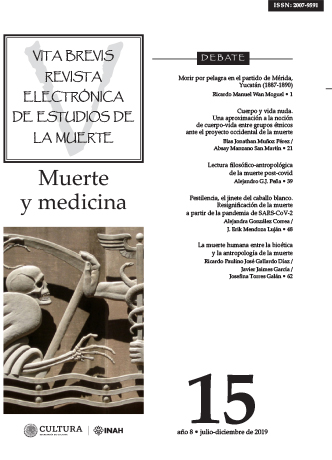Published 2023-02-28
Keywords
- Muerte,
- Antropología,
- Bioética,
- Tanatología
Copyright (c) 2019 Instituto Nacional de Antropología e Historia

This work is licensed under a Creative Commons Attribution-NonCommercial 4.0 International License.
How to Cite
Abstract
The death of the human being, the greatest dilemma of humanity, for which there is no satisfactory answer and if it has generated the most diverse opinions and explanations: from religions to philosophy and from here to science; without so far there being an answer that answers the doubts of humans. As a fatal fact recognizing the death of the human, it has not always been the task of medicine; for practically this is done from the S. XVIII when the stethoscope was used to prepare the referred diagnosis, obviously countless claims must have occurred in the face of it, for in some places death was recognized until the corpse began to show signs of decomposition. As technology applied to medicine progressed, various ways of clinically and technically integrating the diagnosis of death were designed, At the same time, conflicts related to medical conduct appear, as well as family members due to the absolute fact. With Medical Ethics many dilemmas were solved and with the advent of Bioethics and the new field established with Thanatology is how the field of knowledge around to the death of living beings, considering in this the human being. We intend to approach human death from two points of view: Medical Anthropology and Bioethics, obviously addressing Tanatology as the discipline that currently tries to explain the fatal and absolute fact.
Downloads
References
- “DSM-IV”, criterios diagnósticos de los trastornos mentales, en Diagnostic and statistical manual of mental disorders. 4ª ed., 1994, Washington D.C., American Psychiatric Association, recuperado de: https://www.infogerontologia.com/pop_out/patol_criterios_diagnosticos/dsm_iv/otros/problemas_adicionales.html consultada el 8 de septiembre de 2021.
- Guía de consulta de los criterios diagnósticos de DSM-V, 2014, Washington, D.C./ Londres, American Psychiatric Association, recuperado de: https://www.eafit.edu.co/ninos/reddelaspreguntas/Documents/dsm-v-guia-consulta-manual-diagnosticoestadistico-trastornos-mentales.pdf, consultada el 8 de septiembre de 2021.
- Escobar Picasso, E. y A.L. Escobar Cosme, “Principales corrientes filosóficas en bioética”, Boletín Médico del Hospital Infantil de México, vol. 67, núm. 3, 2010, pp. 196-203, recuperado de: <http://www.scielo.org.mx/pdf/bmim/v67n3/v67n3a3.pdf
- González Quintana, Constantino, “Bioética narrativa”, Revista Conamed, vol. 22, núm. 4, 2017, recuperado de: https://www.medigraphic.com/pdfs/conamed/con-2017/con174h.pdf consultada el 8 de septiembre de 2021.
- Gutiérrez Samperio, César, “¿Qué es el encarnizamiento terapéutico?”, Cirugía General, vol. 38, núm. 3, 2020, recuperado de: http://www.scielo.org.mx/scielo.php?script=sci_arttext&pid=S1405-00992016000300121 consultada el 10 de septiembre de 2021.
- Ocio, Sergio, Psicología médica (curso 2018-2019), España, Universidad de Oviedo, s.f., recuperado de: https://areapsiquiatria.unioviedo.es/wp-content/uploads/2019/03/El-duelo-y-las-repercusiones-de-la-muerte-en-la-familia-1.pdf, consultada el 8 de septiembre de 2021.
- Palma Mora, Serafín y Ricardo Bello Gutiérrez, “La bioética y su objeto de estudio. Consideraciones generales”, Acta Médica del Centro. Revista del Hospital Clínico Quirúrgico “Arnaldo Milián Castro”, vol. 4, núm. 4, 2010, recuperado de: http://www.revactamedicacentro.sld.cu/index.php/amc/article/view/538 consultada el 7 de septiembre de 2021.
- Quinaglia Silva, Érica, “Ideario de la muerte en Occidente: la bioética en una perspectiva antropológica crítica”, Revista Bioética. vol. 27, núm.1, enero-marzo de 2019, pp. 39-41.
- Reyes-Acevedo, Rafael, “Ética y trasplantes de órganos: búsqueda continua de lo que es aceptable”, Revista de Investigación Clínica, vol. 57, núm. 2, marzo-abril de 2005, recuperado de: http://www.scielo.org.mx/scielo.php?script=sci_arttext&pid=S0034-83762005000200011 consultada el 10 de septiembre de 2021.
- Siurana Aparisi, Juan Carlos, “Los principios de la bioética y el surgimiento de una bioética intercultural”, Veritas, núm. 22, 2010, pp. 121-157, recuperado de: https://dx.doi.org/10.4067/S0718-92732010000100006

